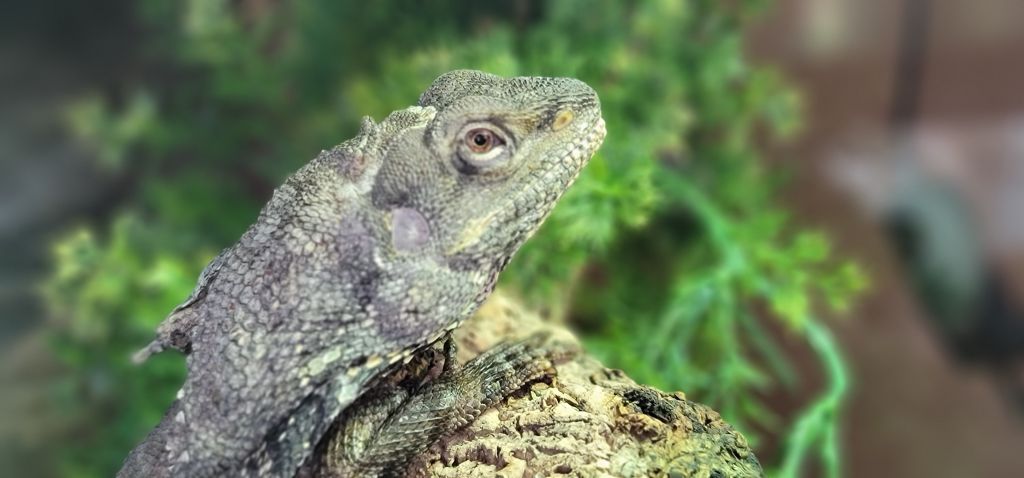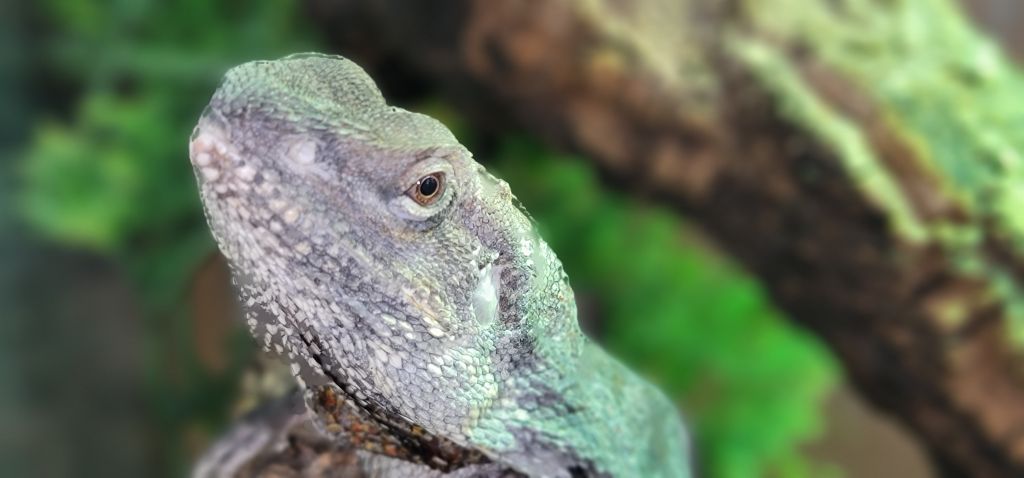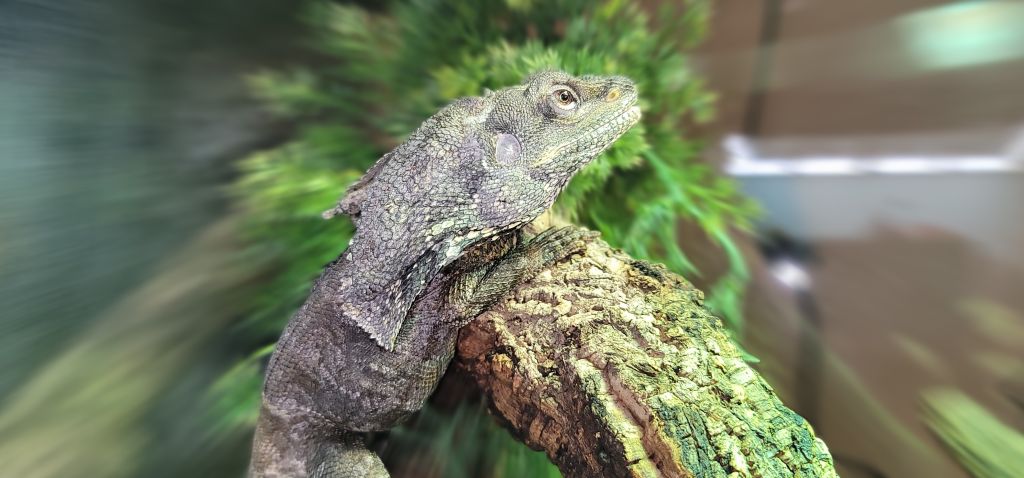MEET NIGEL
Nigel is a frilled lizard, also known as a frilled dragon or a frilled-neck lizard. He has a ¾ Australian, ¼ New Guinea heritage. A year ago, Nigel arrived at Jurupa Mountains Discovery Center as a mere youngster, about ten months old. Since his arrival here, Nigel has grown several inches and is well on his way to the three feet in length (including his tail) he will reach as an adult.
DRAGON FAMILY
Nigel belongs to the dragon family. No, not the dragons of myths and fairy tales. He belongs to a family of lizards known as dragons because of their perceived similarities to the dragons of lore.
All lizards in this group have sharp, chisel-shaped teeth that are fixed to the jaw. Some dragon lizards may have spines, crests, or, like Nigel, flaps on the head or back. The dragon lizards category also includes the Komodo dragon and the bearded dragon, putting Nigel in with some pretty impressive company.
WHERE DO FRILLED DRAGON’S GET THEIR NAME?
The frilled dragon gets its name from the ruff of skin it keeps folded behind its head. When frightened, this lizard stands on its hind legs, opens its mouth wide, and ruffles out a colorful scaly red and yellow frill to intimidate its attacker by making the lizard appear much larger and scarier than it actually is.
THE FRILL
The frill is a large, colorful, circular membrane of skin that projects both upwards and outwards from the lizard’s neck. It is supported by spines connected to the lizard’s jawbones and can only be erected while the lizard is opening its mouth.
The frill can be up to 12 inches in diameter when it is fully erect. In addition to displaying its frill, the lizard will also stand up on two legs with its mouth wide and let out a loud hiss to try and frighten its predators away.
When trying to escape potential danger, the frilled lizard will run using only its hind legs. At JMDC, Nigel rarely extends the frill around its neck, although we occasionally get the opportunity to see it when he is stretching.
THEIR ENVIRONMENT
Frilled dragons prefer a warm, almost hot, and humid environment. They are native to the tropical parts of northern Australia and southern New Guinea, where they inhabit forests and woodlands with lots of trees.
Frilled dragons are active during the day. They love the warmth of the sun and enjoy basking during morning hours and in the early afternoon.
We keep the temperature and humidity in Nigel’s enclosure at levels similar to those he would be enjoying in nature. Nigel spends much of his morning on a tree branch, basking in the warmth of a heat lamp.

PROTECTING THEMSELVES FROM PREDATORS
Nigel, like all frilled dragons, is arboreal. In the wild, a frilled dragon will spend up to 90% of its time in trees.
A frilled dragon has grey and brown scaly skin with patterns similar to tree bark which helps it easily blend with the surrounding environment and makes it very difficult for predators to see.
Frilled dragons spend much of their time-pressed flat against the trunk of trees watching for predators and looking for food.
ON THE HUNT
Frilled dragons are ambush predators meaning they hunt by lying in wait for prey to pass close by and then pounce on their victims. They eat a variety of insects such as spiders, beetles, termites, cicadas, and ants. They have also been known to make a meal of smaller lizards and mammals.
They prefer to hunt for food within the trees’ safety where they can remain hidden from predators. However, the food search will, at times, force them to venture out of the trees and onto the ground where they are more exposed.
WHEN FRILLED DRAGONS FEEL THREATENED
If the lizard finds itself in a position where it feels threatened, its first instinct is to run toward the nearest tree or lie motionless. But if neither seems like an option, the lizard fights back, utilizing the frill for which he is recognized and named. Nigel does not need to hunt for his food but is instead offered a daily meal of super worms and crickets with the occasional cockroach.

NIGEL’S FAVORITE MEAL
To be honest, Nigel’s favorite meal is a squishy hornworm. Nigel gets water by drinking water droplets that have been collected on the leaves in his enclosure, similar to how he would hydrate in nature.
BREEDING
Frilled dragons are territorial and prefer to live alone except during mating season. Breeding takes place during the wet season, usually between October and March. While mating, males will fight one another and use their frill to impress a female. After mating has occurred, the female will lay anywhere between four to thirteen eggs, with the average size of a clutch being eight.
WHAT DECIDES THE SEX?
Nests are located in flat areas with sandy soil and little grass or leaf litter and no vegetation directly over the nest. This allows the nest to receive sunlight for most of the day. The sun incubates the eggs, and it usually takes several months for them to hatch, depending on the temperature.
The incubation temperature decides the sex of a frilled dragon’s offspring during a specific temperature-sensitive period of the egg’s development. Warmer temperatures will produce more females, while cooler temperatures result in an equal number of male and female offspring. Newly hatched frilled dragons have full use of their frill and can survive on their own without help from the mother.
BORN FAMOUS
As you might imagine, as an Australian native, the frilled dragon is quite popular in that region, with its image being incorporated into the culture. For example, the Australian 2-cent coin featured a frilled dragon on its reverse side up until 1991. Also, a frilled dragon named “Lizzie” was the mascot for the 2000 Paralympic Games held in Australia.

ON THE BIG SCREEN
The frilled dragon has also had some success on the big screen. Its unique appearance and behavior make it a fun addition to movies. You can see a frilled dragon named Frank in the Disney film The Rescuers Down Under.
In the original Jurassic Park movie, the dinosaur Dilophosaurus was loosely modeled after the frilled dragon with a similar neck frill which is raised while it was attacking. However, it is important to note that frilled dragons are neither venomous nor do they spit like the dinosaurs in Jurassic Park.
GOOD PETS
Frilled dragons can make good pets with proper care. And Nigel is living proof. While he was timid when we first acquired him, our JMDC critter handlers are working with him so that he is comfortable coming out of his enclosure to greet visitors and for future educational programs. He has a tree branch to bask on and all the worms and crickets he desires. Nigel can survive up to 20 years in captivity, so we look forward to having him here at JMDC for many years to come.

